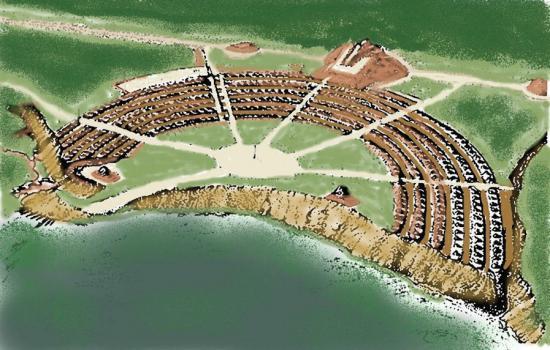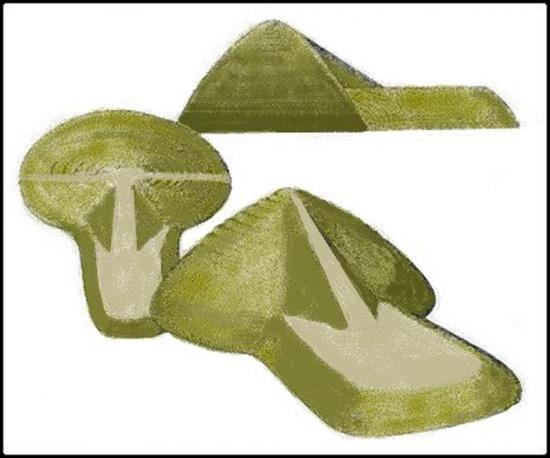PART.2
Approximately, 1,200 years after Watson Brake was abandoned, construction began in the region of a large village raised on concentric earthen platforms. The villagers also built several earthen mounds. The main mound is the oldest and the largest effigy mound ever built. It appears to be in the abstract form of a bird. Today the site is adjacent to a bayou, but 3,600 years ago, it was probably fairly close to the old channel of the Mississippi River. The village site is now called Poverty Point.

The village at Poverty Point was directly adjacen to a bayou and in the past, close to the old channel of the Mississippi River. Credit: designer color sketch by Richard Thornton
There is also debate concerning the reason for Poverty Point’s earthen platforms. There is no doubt about how these platforms were built. They were communal construction projects that were built one at a time. Someone designed the rings and they were added as the village’s population grew.

The main mound at Poverty Point is one of the largest Indian mounds in Louisiana, even though it is the second oldest. Credit: designer colors sketch by Richard Thornton
An enormous amount of human labor went into the construction of these earthworks. Louisiana archaeologists have not found any evidence that there was elite at Poverty Point that disproportionately, from the labors of the entire community. Since the massive earth-moving appears to have been an activity that benefited the entire community, one obvious interpretation is that placing the village onto earthen platforms protected its occupants from seasonal floods.
Mound building elsewhere in the world.
Mound-building was an architectural tradition practiced by many early cultures around the world, particularly in Manchuria, Korea, Japan and Scandinavia. There are over 25,000 Neolithic and Bronze Age mounds protected by the government of Denmark. There are hundreds of mounds in the vicinity of Landskrona in southern Sweden and near Uppsala in central Sweden.

There are several Neolithic Period mounds in Korea which are arrange in an oval or circle, like Watson Brake. Credit: Wikipedia Commons
Until World War II the Tungus-Manchu sun-worshipers of Manchuria built pyramidal earthen temple mounds that are almost identical to those found in the New World. The Neolithic (late Stone Age) mounds of Korea were often built is circular arrangement like those at Watson Brake. Does that suggest that the inspiration for Watson Brake came from an ancient tradition in northeastern Asia? No artifacts have been found to directly tie the contemporary cultures of Louisiana and Korea together, but it always possible. Mound-building may have been a cultural tradition brought to the New World by American Indians. Perhaps there are older mounds in the Americas that just have not been found.
It is always possible that the early mounds and platform villages of Louisiana were merely a local, albeit very early, manifestation of traditions found around the world. However, the fact that all were located near rivers, subject to seasonal flooding, suggests that these ancient mounds had a very practical function, survival during floods. Such an important function would have encouraged hunter-gatherer communities to take time out from obtaining food, in order to join with their neighbors and family members in the laborous task of stacking seemingly endless basket loads of dirt.

CIV 106 : Civilisations paléo-indiennes / Amerindians of North America